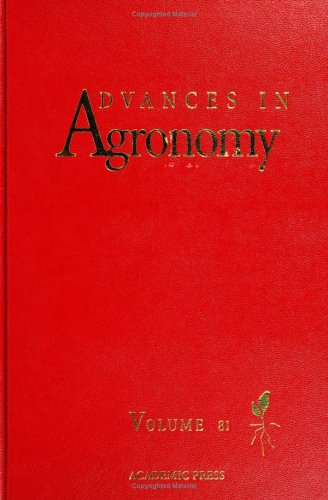

Most ebook files are in PDF format, so you can easily read them using various software such as Foxit Reader or directly on the Google Chrome browser.
Some ebook files are released by publishers in other formats such as .awz, .mobi, .epub, .fb2, etc. You may need to install specific software to read these formats on mobile/PC, such as Calibre.
Please read the tutorial at this link. https://ebooknice.com/page/post?id=faq
We offer FREE conversion to the popular formats you request; however, this may take some time. Therefore, right after payment, please email us, and we will try to provide the service as quickly as possible.
For some exceptional file formats or broken links (if any), please refrain from opening any disputes. Instead, email us first, and we will try to assist within a maximum of 6 hours.
EbookNice Team

Status:
Available5.0
21 reviews
ISBN 10: 0120007991
ISBN 13: 9780120007998
Author: Donald L. Sparks
Recognized as a leading reference in agronomy with the highest impact factor among agriculture serials
Contains five in-depth review chapters focused on critical issues in agricultural and environmental sustainability
Covers timely, cross-disciplinary topics across agronomy, soil science, plant science, and environmental science
THE GLOBAL IMPACT OF SOIL EROSION ON PRODUCTIVITY
I: ABSOLUTE AND RELATIVE EROSION-INDUCED YIELD LOSSES
Christoffel den Biggelaar, Rattan Lal, Keith Wiebe and Vince Breneman
I. Introduction
II. Data Sources and Analyses
A. Data Sources
B. Data Analysis and Interpretation
C. Location of, and Methods Employed in, the Erosion-Productivity Studies
III. Assumptions
A. Yield as a Measure of Productivity
B. Mean Yield Decline
C. Linear Relation
D. Average Bulk Density
E. Relative Yield Decline
IV. Results
A. Effects on Yield in TSD Experiments
B. Erosional Effects on Yield in Management Practices Studies
C. Effects of Inputs
V. Discussion and Conclusions
References
THE GLOBAL IMPACT OF SOIL EROSION ON PRODUCTIVITY
II: EFFECTS ON CROP YIELDS AND PRODUCTION OVER TIME
Christoffel den Biggelaar, Rattan Lal, Keith Wiebe, Hari Eswaran, Vince Breneman and Paul Reich
1. Introduction
A. Effect of Erosion on Food Production
B. Effect of Erosion on Food Security
C. Erosion-productivity Estimates
II. Objectives of the Present Study
III. Methods
A. Data Sources.
B. Potential Erosion Rate Estimates
C. Estimates of Potential Crop Growing Areas
D. Crop Yield Estimation.
E. Data Analysis
IV. Results
A. Maize
B. Millet and Sorghum.
C. Potatoes
D. Soybeans.
E. Wheat.
F. Value of Production Losses
V. Discussion and Conclusion.
References.
PLANT GROWTH PROMOTING RHIZOBACTERIA: APPLICATIONS AND PERSPECTIVES IN AGRICULTURE
Zahir A. Zahir, Muhammad Arshad and William T. Frankenberger, Jr.
I. Introduction
II. Mechanisms of Action.
A. Biological Nitrogen Fixation
B. Production of Plant Growth Regulators and Biologically Active Substances.
C. Solubilization and Uptake of Nutrients
D. Biological Control..
III. Screening of PGPR
A. Root/Shoot Growth Under Gnotobiotic Conditions
B. In Vitro Production of Plant Growth Regulators
C. 1-Aminocyclopropane-1-Carboxylic Acid (ACC) Deaminase Activity
IV. Application of PGPR in Agriculture..
A. Effect of PGPR Inoculation on Cereals.
B. Effect of PGPR Inoculation on Other Crops
C. Rhizobia as PGPR in Non-Legumes
D. Co-Inoculation of Legumes with PGPR and Rhizobium
E. Precursor-Inoculum Interactions
V. Concluding Remarks.
Acknowledgements
References
ORGANIC MATTER ACCUMULATION IN SUBMERGED SOILS
Kanwar L. Sahrawat
I. Introduction
II. Decomposition of Organic Materials in Submerged Soils
A. Factors Affecting Organic Matter Decomposition
III. Organic Matter Accumulation in Wetland Soils
A. Factors Influencing Organic Matter Accumulation.
IV. Mechanisms for Organic Matter Accumulation in Wetlands.
A. Lack of Oxygen or Anaerobiosis
B. Deficiency of Nutrients
C. Lack of Terminal Electron Acceptors.
D. Production of Inhibitors of Microbial Activity.
E. Formation of Recalcitrant Complexes...
F. Incomplete Decomposition and Decreased Humification of Organic Matter
G. High Primary Productivity
V. Modeling Organic Matter in Wetland Soils.
VI. Perspectives
References
POTASSIUM NUTRITION OF THE RICE-WHEAT CROPPING SYSTEM
Bijay Singh, Yadvinder Singh, Patricia Imas and Xie Jian-chang
I. Introduction
II. The Rice-wheat Cropping Systems
A. Distribution.
B. Characteristics.
III. Potassium Fertilizer Use in the Rice-wheat Cropping Systems
IV. Potassium Fertility of Soils Under Rice-wheat Cropping Systems.
A. Mineralogy of Soil Potassium.
B. Forms of Soil Potassium
C. Potassium Transformations in Soils
D. Assessment of Soil K-supplying Capacity
V. Potassium Uptake by Rice-wheat Cropping Systems
VI. Response of Rice-wheat Cropping Systems to Applied Potassium.
A. Time, Source and Method of Potassium Application
B. Interactions of Potassium with Other Nutrients
C. Effect of Potassium Fertility Status of Soils
on Response to Potassium
D. Site-specific Potassium Management for Rice and Wheat
E. Potassium Use and Resistance to Disease and Pest Incidence.
VII. Potassium Balance in Soil-plant Systems
VIII. Changes in Potassium Fertility in the Soil Under
Rice-wheat Cropping Systems
IX. Research Needs.
X. Conclusions
References.
INDEX
journal of advances in agronomy and crop science
recent advances in agronomy
advances in agronomy impact factor
advances in agronomy journal
advances in agronomy impact factor 2024
Tags: Donald Sparks, Advances in Agronomy